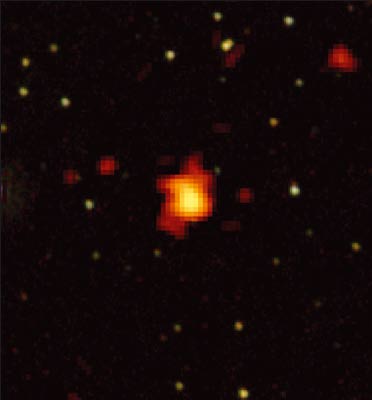
Image credit: NASA/Swift/Stefan Immler.
The Fermi Gamma-ray Space Telescope has observed the evolution of a gamma-ray burst over six orders of magnitude in photon energy. The combination of its brightness and its remote distance makes it by far the most energetic gamma-ray blast ever seen. Furthermore, the observed delay of the highest-energy emission gives a lower limit on the strength of quantum-gravity effects.
Since the launch of the Swift satellite in November 2004, up to a few gamma-ray bursts (GRBs) are routinely detected every day. The phenomenon now seems commonplace and only the record-breaking bursts attract public attention.
After the “Rosetta stone” GRB 030329 and the “naked-eye” GRB 080319B, here comes the “extreme” GRB 080916C. This giant burst was observed by Fermi, which was launched into space last year. It is one of the rare bursts detected up to giga-electron-volt energies by the Large Area Telescope (LAT), the main instrument aboard Fermi. In five months the LAT has detected only 3 GRBs out of 58 that were in its field of view, according to the positions provided by the secondary instrument, the Gamma-ray Burst Monitor (GBM).
The burst of 16 September 2008, GRB 080916C, was the brightest observed so far and the only one with a distance determined by an observed redshift. The redshift of z = 4.35 ± 0.15, measured by the Gamma-Ray Burst Optical/Near-Infrared Detector (GROUND) on the 2.2 m Max Planck Telescope at La Silla, in Chile, locates the collapsing-star event at a distance of 12.2 thousand million light-years. This cosmological distance means that GRB 080916C was intrinsically extremely luminous – at least twice as much as the previous record-holder, GRB 990123, which was observed by the Energetic Gamma-Ray Experiment Telescope aboard the Compton Gamma-Ray Observatory.
The Fermi LAT and Fermi GBM collaborations have jointly published a detailed analysis of the emission of this extreme burst. The combined GBM and LAT spectra – covering the range from 8 keV to 300 GeV – are consistent with a very simple spectral shape. Spectra were extracted for five distinct epochs during the evolution of the burst and all have the simple form of a Band function, which smoothly joins low- and high-energy power laws. A simple physical interpretation for such spectra is synchrotron radiation of charged particles in a magnetic field, but this cannot be confirmed, because the synchrotron self-Compton emission expected in this case could not be detected.
The most interesting result is probably the evidence of a consistently increasing delay of higher-energy radiation during the second peak of the GRB emission. This time lag can be intrinsic to the source or induced by quantum-gravity effects along the path from the remote source to the telescope. The delay by about 16 s of the most energetic photon – 13 GeV – with respect to the on-set of the burst allows the researchers to derive a lower limit on the quantum-gravity mass of only about one order of magnitude below the Planck mass. The question of whether the observed delay is intrinsic to the source or results from its long journey through the quantum foam of space–time will eventually be solved with the detection of several other bursts with known redshift and measurable time delays.





